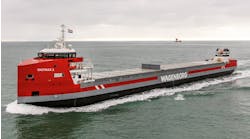Weldox weight-saving properties benefit cranes, deck structures and mooring systems
Jennifer Pallanich Hull
Special Reports Editor
SSAB Oxelösund's strength is the production of extra high strength, special steels. Its steel-works in Oxelösund, Sweden has a production line stretching from iron ore to finished rolled plate. The company, which produces heavy plate in thicknesses from 4 mm upwards, offers the Hardox, Weldox, Armox and Toolox lines. Hardox is quenched and tempered wear-resistant steel produced in hardnesses of up to 600 HB. Weldox is a structural steel with yield strengths of up to 1,100 N/sq mm. Armox is a protection plate with hardness up to 600 HB. Toolox, the latest product, is a pre-hardened tool steel.
null
One of the company's newest investments is the Oxelösund's AccuRollTech ExtraClose system. This allows steel to be rolled to within a +/- 0.25-mm thickness accuracy rating. The steel can be closer to its specified thickness, improving predictability about the weight. The four-high rolling mill guarantees the accuracy of the steel plate for products requiring an extremely high degree of precision. No other facility in the world can offer this accuracy, according to Anders Samuelsson, product manager for the Weldox range: "This gives the designer much better control over the final weight."
Weldox is the range most relevant to the offshore sector. This is an extra high-strength steel for load-bearing structures such as A-frames, deck cranes and other deck structures, winches, and other mooring handling equipment. The plate is available with guaranteed yield strengths of between 420 N/sq mm and 1,100 N/sq mm. Weldox structural plate was developed to ensure good weldability, and due to its low content of inclusions, the plate is highly malleable. All Weldox steels meet the requirements of European EN standards. However, Weldox 1100 exhibits better properties than those specified by the standard. SSAB claims this is the world's strongest structural plate.
Weldox 1100's plate thicknesses range from 5 mm to 25 mm, and the quenched plate offers tensile strength of 1,250-1,550 N/sq mm. Because Weldox 1100 obtains its mechanical properties through a quenching process, the company says, it is not suited for fabrication operations at temperatures above 200° C. Weldox 1100 has the same weight:strength ratio as qualified aluminum alloys, Samuelsson said, making it an obvious candidate for helidecks. Weldox 1100 would be safer than aluminum for this use because of its higher yield strength, he added.
There is growing interest in use of Weldox 900 for offshore deck structures. Samuelsson claimed that for each 10 metric tons of deckweight saved through use of this steel, there could be a consequent 25 metric ton reduction in ballast. Weldox 900 can also be used in various parts of mooring systems. For plate thickness from 4 mm to 50 mm, the plate offers tensile strength of 940-1,100 N/sq mm. For plate thickness from 50 mm to 80 mm, the plate offers tensile strength of 880-1,100 N/sq mm.
null
Weldox 700 is used for similar applications. For plate thickness from 4 mm to 100 mm, the plate offers tensile strength of 780-930 N/sq mm. For plate thickness from 100 mm to 130 mm, the plate provides tensile strength of 710-900 N/sq mm. Because Weldox 700 achieves its strength from quenching and tempering, it is not recommended for fabrication operations at temperatures exceeding 580° C.
A crane with a lifting capacity of 120 ton-meters was built for a vessel. Changing the design and using Weldox 700 instead of S355-type steel meant thinner material could be used. The change led to a weight saving of 4.5 tonnes, or a 30% weight reduction compared to the old design. SSAB believes even further weight savings are possible, Samuelsson said.
For more information, contact Anders Samuelsson, SSAB Oxelösund. Tel: +46 155 25 44 45, fax: +46 155 25 55 40, email: [email protected], website: www.ssabox.com.





